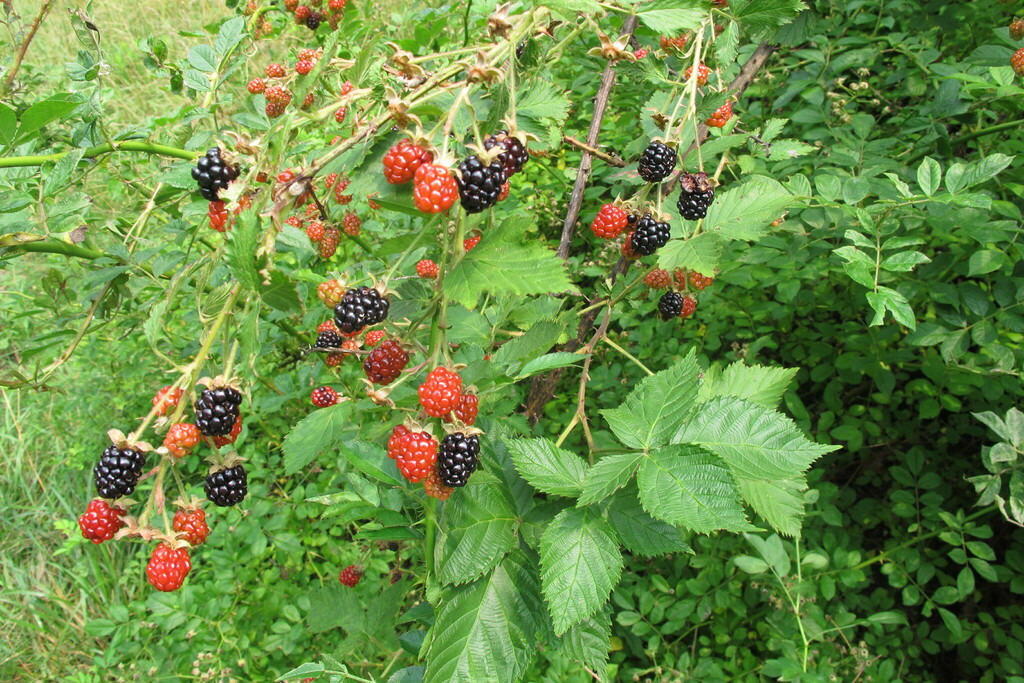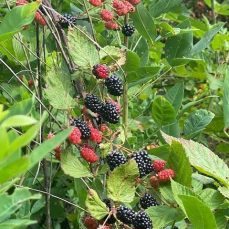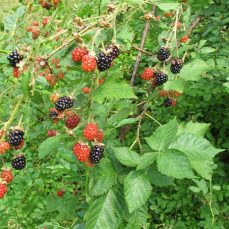Common Blackberry (Rubus allegheniensis)

Photo credit: linkmdavis, iNaturalist

Management Strategy
Squamish
Whistler
Pemberton
Vectors of Spread
Synonyms
Allegheny blackberry
ID Characteristics
General: Common blackberry is a biennial bramble. The flowers and fruit only form on mature stems.
Flowers: Form in clusters of roughly 15 white flowers, each with 5 petals. Common blackberry flowers only form on second year stems.
Stem: Upright to arched; canes are angled, branched and have curved prickles. Canes are biennial and can root along the stems and tips. Common blackberry plants are 1 – 2 m tall.
Leaves: Medium to dark green, made of 5 leaflets that are deeply divided and look lobed with toothy margins. The leaves have hairy undersides.
Fruit: Mature, shiny blackberries ripen in late summer. Berries only form on second year stems.
Roots: Taproot.
Similar Species
Native
Trailing blackberry (Rubus ursinus) is the only native blackberry to BC. It is a low, trailing plant with leaves divided into 3 distinct leaflets that are 15 cm long, dark green on both sides and toothed. Flowers are white or pink and are 2.5 cm wide. Trailing blackberry produces small blackberries and can be found growing in disturbed sites and dry, open forests at low to mid elevations, making them prevalent on Vancouver Island and the lower mainland.

Black raspberry (Rubus leucodermis) is sometimes confused with common blackberry. However, it is native to BC and can be recognized by the white residue on its stems (canes).

Source: Wikipedia
Invasive
Himalayan blackberry is taller than common blackberry, as it grows up to 3m tall.

Cutleaf evergreen blackberry leaves are deeply divided with toothy margins.

Credit: LJ. Mehrhoff, bugwood.org
Habitat and Origin
Common blackberry is native to Eastern North America. In Canada, it naturally occurs from Nova Scotia to Quebec; in the US, it grows from Minnesota south to North Carolina, Alabama, Missouri, and Oklahoma. Common blackberry is thought to have arrived in Western North America by escaping from cultivation.
Common blackberry thrives in a wide range of habitats, such as disturbed areas, dry upland pastures, forest plantations, roadsides, and forest edges. It grows in a range of soil conditions, but it is not tolerant of shade.
How it Spreads
Common blackberry can reproduce both by seed and vegetatively. Vegetative reproduction occurs by sprouting root buds and root developments on canes.
Common blackberry spreads vegetatively by rooting from the cane tips touching the ground or from nodes along the cane. Common blackberry seeds are spread by birds and mammals eating the fruit and dispersing the seeds to new locations, as the seeds can remain intact through animals’ digestive tracts.
Impacts
Ecological:
- Outcompetes native plants.
- Reduces biodiversity.
- Infests stream channels and banks.
- Restricts the access of wildlife to water bodies.
- Degrades pastures.
- Increases the likelihood of erosion along banks.
Economic:
- Reduces land value.
- Limits recreational access to water bodies.
- Reduces sight lines along infrastructure.
Stop the Spread
Common blackberry is found in the Sea to Sky region and its distribution is beyond landscape-level control. When Common blackberry is present at high-priority locations and negatively impacting them, their control is considered a high priority.
Otherwise, the goal is to prevent it from spreading to new (uninfested) areas, and to control it where possible to limit its impact on biodiversity.
Learn to identify common blackberry: Use the images presented in this profile page to learn how to identify common blackberry.
What to do if you spot it: You can report any common blackberry sighting by visiting our reporting page.
DO:
- Regularly monitor properties for weed infestations.
- Ensure soil and gravel are uncontaminated before transport.
- Maintain or establish healthy native plant communities that are resistant to invasion by invasive plants.
- Ensure plants are disposed of in a garbage bag if found in floral arrangements to prevent seeds from spreading.
DO NOT:
- Unload, park or store equipment or vehicles in infested areas; remove plant material from any equipment, vehicles or clothing used in such areas and wash equipment and vehicles at designated cleaning sites before leaving infested areas.
- Plant Common Blackberry in a garden, no matter how well-contained its enclosure may seem.
- Move soil that has been contaminated with common blackberry.
- Do not place fruit material in the compost.
Control
Because of its food value, SSISC’s approach is to only use mechanical methods to control invasive Himalayan Blackberry, except at a handful of special case sites, which are not accessible to the public.
Mechanical
- Repeated cutting and mowing can keep plants from over-taking; however, cutting followed immediately by root removal is most effective.
- Pulling canes out of the ground before berry production also helps to control infestations.
Chemical
- It is recommended to treat infestations with glyphosate in the fall, while canes are actively growing, after berries have formed and before the first frost.
- Triclopyr, 2,4-D and metsulfron also provide effective control.
We recommend that any herbicide application is carried out by a person holding a valid BC Pesticide Applicator Certificate. Before selecting and applying herbicides, you must review and follow herbicide labels and application rates; municipal, regional, provincial and federal laws and regulations; species-specific treatment recommendations, and site-specific goals and objectives.
Cultural
Long-term grazing by goats and pigs has been proven effective, and chickens can decrease the seed bank.
Biological
There are no biocontrol agents available for this plant in BC.
Sea to Sky Distribution
Common Blackberry Factsheet
Having trouble viewing the factsheet? Don’t worry, all the information is included on this page. You can also contact us with any questions.
References
- Eflora of North America, Rubus allegheniensis
- Global Biodiversity Information Facility, Rubus allegheniensis
- Illinois Wildflowers, Common Blackberry
- Invasive Species Council of BC, Himalayan Blackberry
- Lady Bird Johnson Wildflower Center, Rubus allegheniensis
- Native Plant Trust, Rubus allegheniensis
- North Carolina State Extension, Rubus allegheniensis
- Northern Ontario Plant Database, Rubus allegheniensis
- Oregon State University, Rubus allegheniensis
- US Department of Agriculture Plants Database, Rubus allegheniensis











